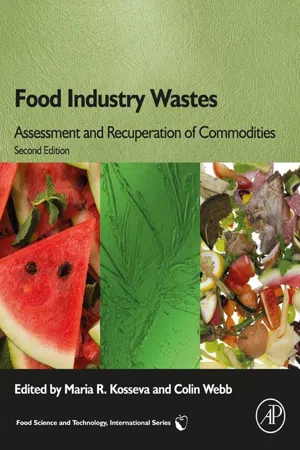Chapter 5
Nutraceutical potential and utilization aspects of food industry by-products and wastes
Krishan Kumar
Abstract
By-products generated by various food-processing industries such as fruits and vegetables, cereals, dairy, seafood, and meat processing represent a rich source of bioactive compounds. When disposed of without processing, these by-products create environmental issues caused mainly by microbial degradation. However, the commercial exploitation of these resources requires the development of appropriate strategies. Various studies have indicated that the bioactive compounds from food industry by-products can be extracted using novel or greener extraction techniques such as supercritical-fluid extraction, pressurized-liquid extraction, microwave-assisted extraction, on so forth. These techniques have been the subject of increased attention in recent years due to their numerous benefits such as lower consumption of organic solvents, higher selectivity, and shorter time of extraction. Different secondary metabolites, minerals, vitamins, and other phytochemicals have been extracted from food by-products using these extraction approaches. The bioactive compounds extracted from food industry by-products can be used as nutraceuticals as well as ingredients for the development of functional foods and can prove helpful in the prevention of various lifestyle diseases by improving the nutritional status of society.
Keywords
Functional foods; phytochemicals; solvent extraction; nutraceuticals; supercritical fluid extraction; pressurized liquid extraction; microwave-assisted extraction; ultrasound-assisted extraction
Glossary
Codex Alimentarius is the international food code providing science-based food standards for use by governments and industry as references for national legislation, trade, and dispute settlement.
Functional foods are consumed as part of a normal diet and deliver one or more active ingredients that have physiological effects and may enhance health within the food matrix.
Nutraceuticals are products isolated from food and are generally sold in medicinal forms such as capsules. It is a diet supplement that delivers a concentrated form of a biologically active component of food in a nonfood matrix to enhance health.
Phytochemicals are chemicals of plant origin.
Percolation is an extractive procedure used most commonly to extract active ingredients during the preparation of tinctures and fluid extracts. In this process, the raw material is extracted from its soluble active constituents by the slow passage of a suitable solvent through it.
Maceration is a method of extraction involving soaking raw material in a coarse or powdered form in a particular solvent at room temperature with repeated agitation. The solvent is removed from the mixture after extraction by vacuum evaporation to concentrate the product.
Reflux extraction is a process of solid-liquid extraction performed at a constant temperature with frequent solvent evaporation and condensation for a specific period without the loss of solvent. It is an efficient, easy to operate, and cost-effective process and widely used in herbal industries for the extraction of active ingredients.
Soxhlet extraction is a technique of extraction accomplished in Soxhlet extractor, a laboratory apparatus invented by Franz von Soxhlet in 1879. It follows the principle of backflow and siphon of the solvent and makes continuous extraction of the needed components in the solid and liquid mixture.
5.1 Introduction
Bioactive components with high nutritive value such as polysaccharides, proteins, fibers, flavor components, and phytochemicals separated from food industry by-products and wastes can be utilized as nutraceuticals as well as ingredients for the development of functional foods (Baiano, 2014; Mirabella et al., 2014).
Dr. Stephen DeFelice coined the term “nutraceutical” from “nutrition” and “pharmaceutical” in 1989 (Kalra, 2003) and it can be defined as a food (or a part of a food) that provides medical or health benefits, including the prevention and/or treatment of diseases (Aggarwal et al., 2009). A working definition of nutraceutical from a science forum stated: a diet supplement that delivers a concentrated form of a biologically active component of food in a non-food matrix to enhance health (Zeisel, 1999). In other words, a nutraceutical can be any substance with recognized nutritional value, such as minerals, vitamins, various amino acids, and fatty acids in the form of dietary supplements from the specific components derived from other sources (Chauhan et al., 2013). Usually it is sold in medicinal forms such as capsules. A functional food can be defined as dietary item that, besides providing nutrients and energy, beneficially controls one or more targeted functions in the body by improving certain physiological responses and/or by reducing the risk of diseases (Nicoletti, 2012). It delivers one or more active ingredients within the food matrix, which distinguishes functional food from nutraceuticals.
The markets for this new type of food are more developed in the USA than the European Union and Japan, where the concept of functional food was introduced nearly 30 years ago. In December 2006 the European Parliament and the Council adopted a new regulation (EC 1924/2006) on nutrition and health claims made on foods. Consequently a list of authorized claims has to be published for all member states, and nutrient profiles has to be established for foods containing health claims (Kosseva, 2013). Other countries have followed Codex Alimen...
